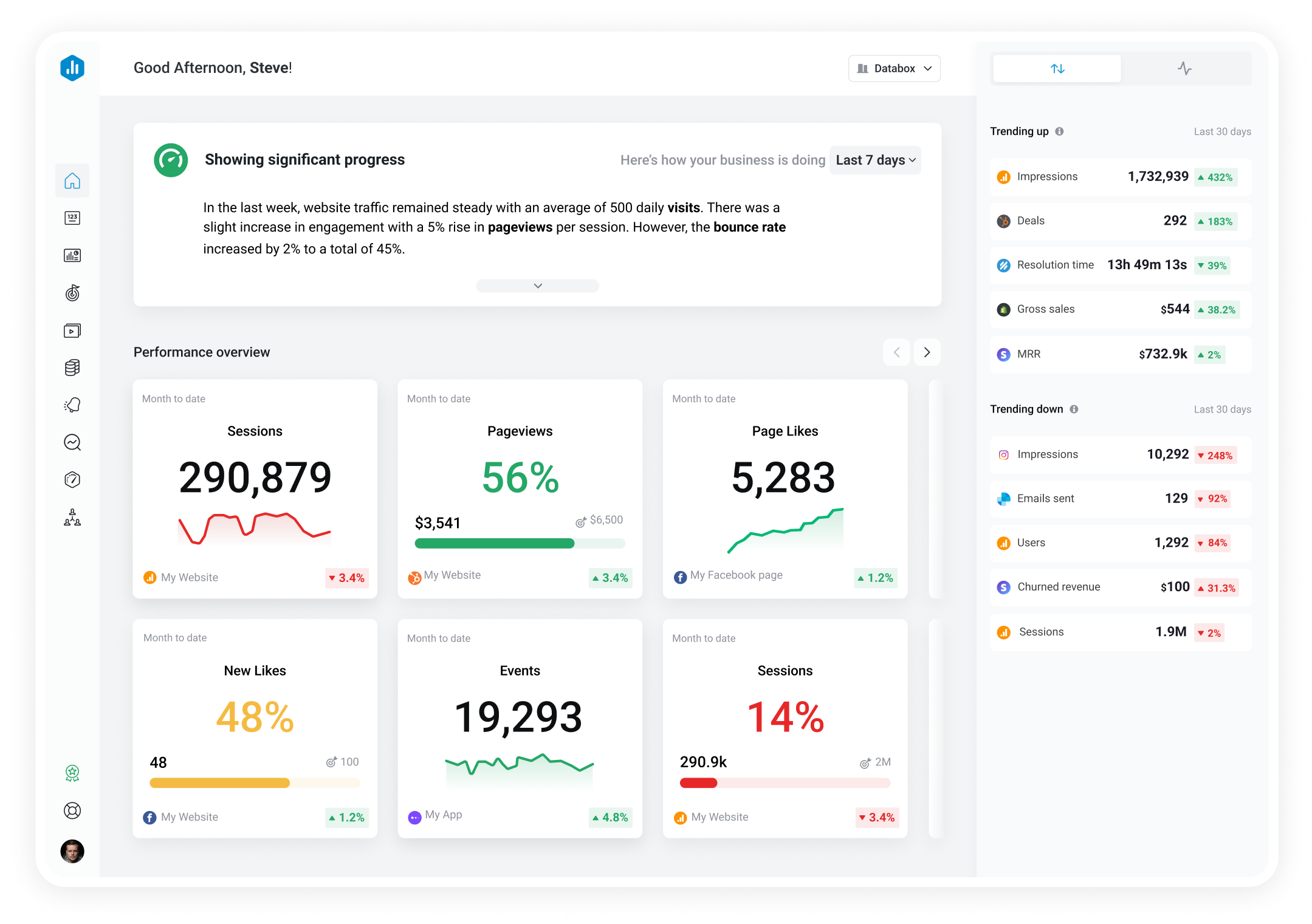Track all of your key business metrics from one screen
GET STARTED
 ProfitWell
Lifetime Value
ProfitWell
Lifetime Value Lifetime Value (LTV) measures the total revenue a customer will bring to a business over their entire lifespan as a customer.
With Databox you can track all your metrics from various data sources in one place.
Lifetime Value (LTV) is a critical metric in marketing and sales that represents the total net profit a customer is expected to generate for a business over the entire duration of their relationship. It quantifies the long-term value of a customer to the company and helps businesses understand the long-term value of each customer, making it easier to create effective marketing strategies, optimize pricing, and allocate resources in areas that will generate the greatest return on investment.
LTV takes into account various factors, including the average purchase value, the frequency of purchases, the customer retention rate, and the operational costs associated with serving the customer.
By calculating LTV, businesses can determine how much they can invest in acquiring new customers and retaining existing ones while remaining profitable.
The basic formula for calculating Lifetime Value (LTV) focuses on three primary inputs: Average Revenue Per User (ARPU), Gross Margin, and Churn Rate.
The formula looks like this: ARPU x Gross Margin / Churn
Let’s consider an e-commerce business that sells beauty products online. Over the past year, they collected data on their customer base and want to calculate the LTV to understand the value of their customers over time.
To calculate ARPU, divide the total revenue generated by the number of customers over the given time period, for example: $500,000 in total revenue from 10,000 unique customers.
ARPU = Total Revenue / Number of Customers
ARPU = $500,000 / 10,000 = $50
Determine gross margin, by calculating the difference between net sales revenue and the cost of revenue, showing the profit margin of the business. For instance, if net sales revenue is $400,000, and the cost of revenue is $150,000:
Gross Margin = Net Sales Revenue – Cost of Revenue
Gross Margin = $400,000 – $150,000 = $250,000
Calculate the churn rate, the percentage of customers who stopped using the product or service during the given period: say it’s 20% during the year.
Churn Rate = 20%
Now, using the inputs we have, we can calculate the LTV for this e-commerce business.
LTV = (ARPU x Gross Margin) / Churn Rate
LTV = ($50 x $250,000) / 20%
LTV = $12,500
In this example, the calculated Lifetime Value (LTV) for the e-commerce business is $12,500. This means that, on average, each customer is expected to generate $12,500 in net profit over their lifetime as a customer.
A good Lifetime Value varies depending on the industry, location, business model, target audience, and other factors.
Generally, a higher LTV is desirable as it indicates that customers bring in more revenue over their lifetime, allowing businesses to recover customer acquisition costs and achieve profitability sooner. A “good” LTV depends on factors such as the average cost of customer acquisition and the company’s profit margins.
Here are some recent benchmarks from US-based companies:
LTV is often considered in relation to Customer Acquisition Cost (CAC). According to some online resources, a 3:1 ratio is considered good.
Keep up with future trends and instantly compare your performance to companies just like yours, regardless of your industry. Join our Benchmark Groups—it’s anonymous and free for everyone!
Let’s go over some effective strategies to enhance LTV:
More resources to help you improve:

Used to show a simple Metric or to draw attention to one key number.

Used to illustrate numerical proportions through the size of the slices.

Used to show comparisons between values.
Databox is a business analytics software that allows you to track and visualize your most important metrics from any data source in one centralized platform.
To track Lifetime Value using Databox, follow these steps:
 Goals
Goals Scorecards
Scorecards Metric Digest
Metric Digest Metric Builder
Metric Builder Data Calculations
Data Calculations Performance Screen
Performance ScreenElevate SaaS decision-making with ProfitWell's "SaaS Key Revenue Metrics" Databox. Gain real-time insights, drive data-driven decisions, and foster team collaboration. Stay competitive and achieve success in the dynamic world of SaaS.

Report for SaaS revenue growth and churn management, providing detailed insights into key metrics like LTV, ARPU, MRR, churn, upgrades, and revenue retention.

Customer Lifetime Value (CLV) and Lifetime Value (LTV) are often used interchangeably, but there can be slight variations in their definitions. CLV typically focuses on the individual customer level, while LTV may refer to the aggregate value of all customers as a whole. The underlying concept remains the same, measuring the total value a customer brings to a business over their lifetime.
LTV is a measure of profit, not revenue. It takes into account the cost of acquiring and serving customers, making it a more accurate indicator of a customer’s value to the business.
Yes, CLV can be negative, in cases where the cost of acquiring and serving a customer outweighs the revenue generated from that customer. A negative CLV indicates that the customer relationship is not profitable and may require further analysis and improvement strategies.
